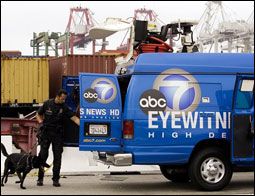By Troy Anderson
The San Gabriel Valley Tribune
LOS ANGELES, Calif. — Even as experts warn the United States’ risk of a terrorist attack is rising, Department of Homeland Security Secretary Michael Chertoff on Friday said port security has been boosted and he is proposing dedicated federal funding to allow local police departments to beef up counterterrorism squads.
Chertoff, who toured the the Los Angeles port area and spoke at USC, said his plan to pay the salaries of counterterrorism officers would allow the Los Angeles Police Department and other agencies to hire more.
 An unidentified officer with U.S. Customs and Border Protection checks the back of a television truck with his sniffing dog before a cargo screening, radiation-scanning technology demonstration held for Homeland Security Secretary Michael Chertoff, at the Long Beach Port in Long Beach, Calif., July 20, 2007. (AP Photo/Damian Dovarganes) |
“For international terrorism, the federal government has the major tools and responsibility to detect terrorism. But when you talk about homegrown terrorism ... we are not going to uncover that in all likelihood with spies and satellites,” he said.
“That is going to be uncovered by police who are trained to look for certain things and then go and disrupt something before it happens.”
Chertoff also defended the federal government’s decision this week to reduce anti-terrorism funding for the Los Angeles-Long Beach region, saying the nation has spent more than $13 billion on homeland security since the 2001 terrorist attacks.
Chertoff said the proposed 10 percent cut from last year’s funding levels was necessary because of demands from communities across the country.
“There’s only one pie, and the way we’ve decided to slice the pie is to put most of the money where most of the risk is,” Chertoff said during comments at the Port of Los Angeles.
“But I’ve got to balance and look at the big picture. Los Angeles gets the second-most amount of money to New York, but it’s also right that San Diego, Las Vegas, and dare I say, Oklahoma City, gets a reasonable amount of money commensurate to risk.”
Chertoff also said radiation monitors are now used at six overseas ports and more than 90 percent of cargo coming into the Los Angeles-Long Beach ports is now scanned for radioactive materials.
Together, the ports handle nearly 45 percent of the nation’s imports, with a total annual value approaching $275 billion.
Chertoff viewed new radiation portal monitors placed at marine terminals to detect radioactive materials used to make “dirty bombs.”
Currently, more than 85 stationary radiation monitors are positioned at marine terminals across the ports, with 24 more such devices attached to trucks, said Aileen Suliveras, Assistant Port Director for U.S. Customs and Border Protection.
The new detection device, which scans containers as they’re hauled out of marine terminals on trucks, is being tested at SSA Terminal on Pier A.
If the new device is successful, authorities hope to have them at seaports and land border crossings across the nation in coming months as funding becomes available.
Staff Writer Kristopher Hanson contributed to this story.
Copyright 2007 San Gabriel Valley Tribune

